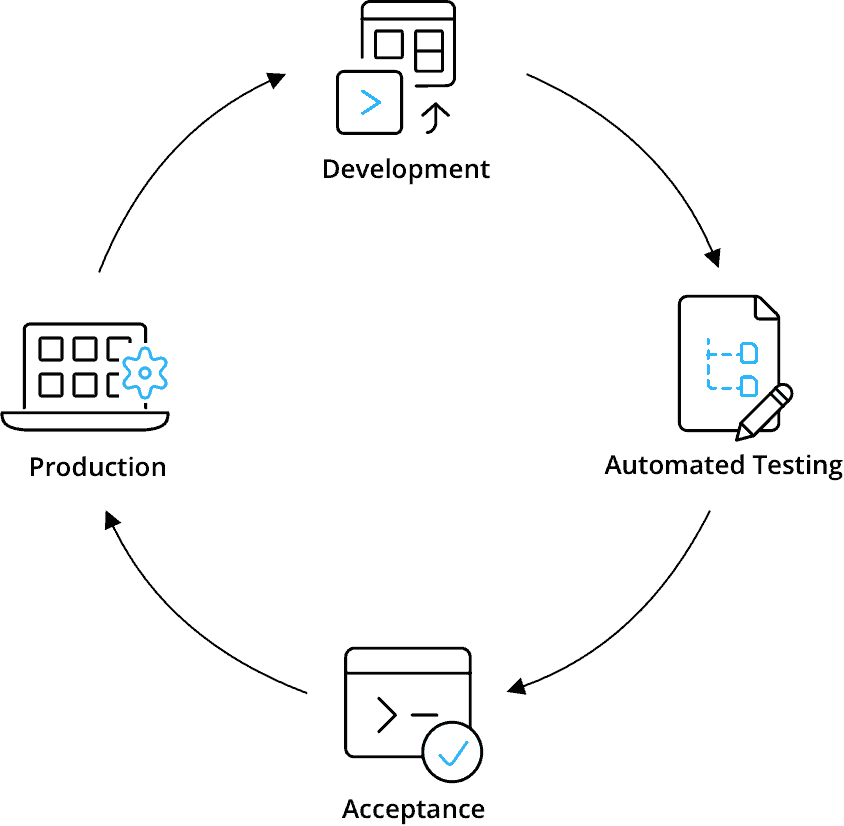In order to stay competitive, eliminate inefficiency, and maximize profit, every company should strive to continuously improve processes. For every process, there will be a newer and more efficient way of doing things. A recent example of this is how companies implemented Agile to improve software development. Now, that process has evolved to include DevOps. In fact, 90% of organizations have implemented or plan to implement DevOps to ensure the success of their digital projects.
But many application projects are still failing to deliver business value. It’s time to improve the process again. It’s time to evolve from DevOps. It’s time to move to BizDevOps.
Agile, DevOps, BizDevOps: How it all started
To understand the next step in process improvement, let’s take a look back. In the 1990s, software companies found immense improvement in solution development by implementing Agile processes. At the turn of the 21st century, the Agile movement made a lot of traditional, stodgy companies profitable. Using the Agile framework, leaping advances in technology were introduced from informal teams turning out skunkworks projects.
In 2001, when the Agile manifesto was published, desktop apps were more prevalent than cloud/SaaS technology and teams could afford infrequent releases. Now that Agile manifesto is old enough to drive and vote, striving to make your development team follow Agile is not going to make the company stand out. IT needs an inclusive framework that focuses not only on software development but also factors in the operations or deployment of the solution. This need has given rise to DevOps.
The prevalent evolution of Agile (and Lean) methods is DevOps. DevOps is a set of practices that combines software development (Dev) and IT operations (Ops) to shorten the cycle to deliver features, fixes, and updates to end-users while keeping solutions reliable, scalable, and secure. DevOps focuses on a better understanding of what users do in production, then, in turn, uses that knowledge to improve user experiences at a rapid, iterative pace. In contrast, the traditional software development processes required predictive guesses and rare validation on what features and optimizations users would most benefit.

DevOps removes obstacles that have historically stood in the way of solution deployment. Gone are the days when pushing code into production involved tons of red tape, weekend go-lives, and late-night troubleshooting. Now automated CI/CD pipelines compile the code, test the apps, and deploy everything automatically. On the operations side, the hardware is now abstracted by the term ‘cloud’, with auto-provisioned environments, automated resource optimization, and high availability. This abstraction dramatically reduces production outages, especially when compared to internet service providers from a decade ago.
While DevOps bridges the divide between the technical departments of development and operations when it comes to building applications that meet business outcomes, about 30 to 35% of the IT projects fail. The reason for this is often the lack of collaboration between business stakeholders and IT, which results in a gap between what teams develop and what the business requires.
To address this gap, the DevOps processes evolved to include the business (Biz) stakeholders. BizDevOps is a software development approach that brings together the non-technical business users, developers, and operations teams into the rapid delivery of customized solutions that align with business and market requirements.
How low-code enhances DevOps: BizDevOps
With Gartner projecting the demand for apps to grow 5x times than IT’s ability to deliver, organizations can use BizDevOps and low-code to accelerate apps to production and fill in cloud environments with solutions that meet business needs. A low-code platform like Mendix facilitates BizDevOps by bringing together the business, development, and operations teams to deliver applications that create value for the business and the end-users. Low-code platforms abstract tedious development and operation tasks required with traditional code frameworks and provide a visual development approach to create multiexperience solutions for mobile, voice, wearables, and more.
Embracing a BizDevOps methodology with a low-code platform offers countless benefits over traditional development approaches, including:
Improved Collaboration
By bringing together development, IT/operations, and the business stakeholders, BizDevOps allows an organization to quickly implement feedback from the end-users. Teams can work across all three functions to speed up development and continuously improve solutions to meet business expectations.
Scaling with Guard Rails
BizDevOps processes built into a low-code platform offer guard rails with proper auto-provisioned environments for testing and acceptance, incredible error checking to avoid commits that can break in deployment, advanced security layers built-in into the solutions, and cloud-native architecture that future proofs the solutions to auto-scale hardware resources based on customer demands.
Better Governance
Get improved control and governance into what features make the most impact on the final product and the solutions that end up being deployed in production.
Detailed Monitoring
Built-in detailed monitoring lets the operations team resolve production errors and involve the development team into fixing production issues monitored by operations.
Automation and Reuse
On the development side, a low-code platform updates all multi-experience mobile, web, voice and other apps with a single visual code base. Users can then deploy changes with one-click, or they can be auto-deployed after a commit, fast-tracking changes to flow directly to end-users.
By integrating business and low-code technology in DevOps, we have finally found the next big improvement in software development – BizDevOps. Low-code allows organizations to continuously improve processes by building a continuous feedback loop from application development to deployment that aligns with business needs, seamlessly putting business, development, and operations together.
Get a jump on BizDevOps. Read the Gartner 2019 Enterprise Low-Code Application Platform Magic Quadrant to see how low-code is going to help you do that.
